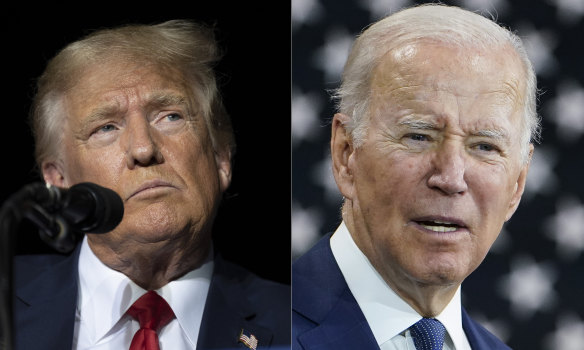By Farrah Tomazin
November 14, 2022
Washington: Joe Biden is constantly underestimated.
A few years ago, he was almost written off while seeking his party’s presidential nomination, only to end up dominating the “Super Tuesday” primary contests to become the candidate chosen to take on Donald Trump.

A staggering loss for Donald Trump, while President Joe Biden is crowing over the Democrats’ success. CREDIT:AP
Later that year, he defied expectations again when he ended up toppling Trump and making the incendiary Republican the first president since 1992 who failed to win a second term.
And at this month’s midterm elections, Biden and his team were widely expected to face a Republican “red wave” that would result in the Democrats easily losing their majority in one or both chambers of the US Congress.
Now, the Democrats have control of the Senate after narrowly winning the key seat of Nevada, while the House of Representatives remains a nail-biter as votes continue to be counted.

Democrats win key Nevada race, giving party control of Senate
Despite record inflation and rising crime; despite polls suggesting most Americans believe their country is on the wrong track; and despite a president with one of the worst approval ratings in history, Biden’s Democrats have had one of the best midterms for a party controlling the White House in decades.
What happened?
First, there can be little doubt that this election was a repudiation of Donald Trump’s grievance-fuelled style of politics and the extremism of his “Make America Great Again” wing of the Republican Party.
Trump endorsed 330 candidates this year, most of whom were running in races that could have given them extraordinary power to set election rules and upend future elections - something Biden and the Democrats kept reminding voters in the final stretch of the campaign.
While the fate of Congress is still too close to call, US President Joe Biden is celebrating after avoiding a bloodbath in the midterms.
Among those defeated last week was candidate for Pennsylvania governor, Doug Mastriano, a far-right politician who helped bus people to Washington on the day of the January 6 Capitol attack and later tried to help Trump overturn the votes in his state. He was beaten by former state attorney general Josh Shapiro last week and only conceded on Monday AEDT.

Once an Oath Keeper: Mark Finchem is a Republican candidate for Arizona Secretary of State.
CREDIT:AP
Another extreme candidate was Mark Finchem, a member of the militia group the Oath Keepers, which is also linked to the US Capitol riots. Finchem was considered a good chance of becoming Arizona’s chief elections official, otherwise known as secretary of state, where he planned to ban early voting and restrict postal ballots, which had been used in Arizona for years.
And in Nevada, which ensured the Democrats have now secured their majority in the Senate, another important result was also called on Friday, against Republican candidate for secretary of state, Jim Marchant.
Marchant had pushed Nevada’s biggest county to switch to hand-counting paper ballots based on Trump-fuelled conspiracy theories about the validity of voting machines.
RELATED ARTICLE

What happens in Nevada will shape the US in next two years
He also led a national coalition of like-minded conservatives also running for secretary of state positions across the US, and at a rally in June, made their intentions clear: “When my coalition of secretary of state candidates around the country get elected, we’re going to fix the whole country and President Trump is going to be president again in 2024!”
Secondly, just as the midterms were a victory for democracy, they were also a rebuke of the US Supreme Court’s decision to overturn the constitutional right to have an abortion.
All around the country, voters delivered a string of decisive victories for reproductive freedom, from Michigan and Montana, to Vermont and California.
The biggest surprise came in the Republican state of Kentucky, where an anti-abortion amendment was defeated, following in the footsteps of a similar attempt in Kansas to remove protections in the state’s constitution earlier this year.

People applaud during a primary watch party in Overland Park, Kansas. State voters rejected a ballot measure in the conservative state with deep ties to the anti-abortion movement.
“We had the best midterms for governors since 1986.
“And experts said we couldn’t beat the odds – but we did.”

Chris Zappone
Digital Foreign Editor
“Election deniers lose races for key state offices in every 2020 battleground”
Another extreme candidate was Mark Finchem, a member of the militia group the Oath Keepers, which is also linked to the US Capitol riots. Finchem was considered a good chance of becoming Arizona’s chief elections official, otherwise known as secretary of state, where he planned to ban early voting and restrict postal ballots, which had been used in Arizona for years.
And in Nevada, which ensured the Democrats have now secured their majority in the Senate, another important result was also called on Friday, against Republican candidate for secretary of state, Jim Marchant.
Marchant had pushed Nevada’s biggest county to switch to hand-counting paper ballots based on Trump-fuelled conspiracy theories about the validity of voting machines.
RELATED ARTICLE

What happens in Nevada will shape the US in next two years
He also led a national coalition of like-minded conservatives also running for secretary of state positions across the US, and at a rally in June, made their intentions clear: “When my coalition of secretary of state candidates around the country get elected, we’re going to fix the whole country and President Trump is going to be president again in 2024!”
Secondly, just as the midterms were a victory for democracy, they were also a rebuke of the US Supreme Court’s decision to overturn the constitutional right to have an abortion.
All around the country, voters delivered a string of decisive victories for reproductive freedom, from Michigan and Montana, to Vermont and California.
The biggest surprise came in the Republican state of Kentucky, where an anti-abortion amendment was defeated, following in the footsteps of a similar attempt in Kansas to remove protections in the state’s constitution earlier this year.

People applaud during a primary watch party in Overland Park, Kansas. State voters rejected a ballot measure in the conservative state with deep ties to the anti-abortion movement.
CREDIT:THE KANSAS CITY STAR/AP
The results suggest that even as Republican states sought to impose severe restrictions on women, much of the public differed, with midterm exit polls showing about 6 in 10 voters believe abortion should be legal in all or most cases.
Biden and the Democrats focused heavily on abortion during the campaign, and in many ways, this issue marks an inflection point in America. Republicans have been running on abortion for years, using it to reliably galvanise their base ahead of elections. Now there’s a chance that Democrats will do the same, reminding voters of what some GOP candidates could do – take away their right to choose – if they control the levers.
There was also a third important factor behind the Democrats’ better-than-expected result: young people.

Culinary Union members Edrulfo Camacho and his mother Angelica door knocking in Las Vegas.
The results suggest that even as Republican states sought to impose severe restrictions on women, much of the public differed, with midterm exit polls showing about 6 in 10 voters believe abortion should be legal in all or most cases.
Biden and the Democrats focused heavily on abortion during the campaign, and in many ways, this issue marks an inflection point in America. Republicans have been running on abortion for years, using it to reliably galvanise their base ahead of elections. Now there’s a chance that Democrats will do the same, reminding voters of what some GOP candidates could do – take away their right to choose – if they control the levers.
There was also a third important factor behind the Democrats’ better-than-expected result: young people.

Culinary Union members Edrulfo Camacho and his mother Angelica door knocking in Las Vegas.
CREDIT:FARRAH TOMAZIN
While the 2022 midterm elections didn’t result in a red wave or blue wave, there was arguably a Generation Z wave, as young people who became old enough to vote over the past decade showed up to make their voices heard.
In Florida, 25-year-old Maxwell Frost last week became the first member of Gen Z elected to serve in the US Congress after campaigning on a platform of gun control, racial justice and universal health care.
In the battleground of Nevada, 21-year-old Edrulfo Camacho – one of many hospitality workers hit hard by the global pandemic – spent weeks doorknocking houses in the suburbs of Las Vegas to sign up more voters to help push incumbent Senator Catherine Cortez Masto over the line.
And the southern state of Mississippi, where the clinic at the centre of the Supreme Court’s decision to overturn Roe v Wade was recently shut down, college student Victoria Akins shared her fears about what might happen if she accidentally fell pregnant but couldn’t access abortion services.
“I don’t want to be in college and exploring life as a student and then something happens to me where I can’t get an abortion,” the part-time shop assistant said.
While votes are still being analysed, preliminary data from the Centre for Information and Research on Civic Learning and Engagement (CIRCLE) suggest an estimated 27 per cent of American youth aged between 18 and 29 cast their ballot this year, the second-highest turnout for a midterm (which generally gets fewer voters than presidential elections).
This proved particularly pivotal in tight contests such as the Senate race for Pennsylvania, where Gen Z-ers increased their share of the electorate from 2018 and supported John Fetterman, the hoodie-wearing, tattoo-covered stroke survivor who beat Trump-backed celebrity doctor Mehmet Oz.
It was meant to be a much easier path for Republicans. After all, history shows that between 1918 and 2016 the president’s party lost an average of 29 seats in the House and an average four seats in the Senate during their first midterm election.

This year, Biden and the Democrats still had pushback, but it was much weaker than anybody expected, by turning the election into a choice between the two parties instead of the usual referendum on the incumbent administration.
And when faced with that choice – a party in the shadow of Trump; the erosion of reproductive freedom; fewer gains for future generations – Biden ended up defying expectations once more.
“We lost fewer seats in the House of Representatives than any Democratic president’s first elected midterm in at least 40 years,” a visibly relieved Biden told supporters in Washington last week.
While the 2022 midterm elections didn’t result in a red wave or blue wave, there was arguably a Generation Z wave, as young people who became old enough to vote over the past decade showed up to make their voices heard.
In Florida, 25-year-old Maxwell Frost last week became the first member of Gen Z elected to serve in the US Congress after campaigning on a platform of gun control, racial justice and universal health care.
In the battleground of Nevada, 21-year-old Edrulfo Camacho – one of many hospitality workers hit hard by the global pandemic – spent weeks doorknocking houses in the suburbs of Las Vegas to sign up more voters to help push incumbent Senator Catherine Cortez Masto over the line.
And the southern state of Mississippi, where the clinic at the centre of the Supreme Court’s decision to overturn Roe v Wade was recently shut down, college student Victoria Akins shared her fears about what might happen if she accidentally fell pregnant but couldn’t access abortion services.
“I don’t want to be in college and exploring life as a student and then something happens to me where I can’t get an abortion,” the part-time shop assistant said.
While votes are still being analysed, preliminary data from the Centre for Information and Research on Civic Learning and Engagement (CIRCLE) suggest an estimated 27 per cent of American youth aged between 18 and 29 cast their ballot this year, the second-highest turnout for a midterm (which generally gets fewer voters than presidential elections).
This proved particularly pivotal in tight contests such as the Senate race for Pennsylvania, where Gen Z-ers increased their share of the electorate from 2018 and supported John Fetterman, the hoodie-wearing, tattoo-covered stroke survivor who beat Trump-backed celebrity doctor Mehmet Oz.
It was meant to be a much easier path for Republicans. After all, history shows that between 1918 and 2016 the president’s party lost an average of 29 seats in the House and an average four seats in the Senate during their first midterm election.

This year, Biden and the Democrats still had pushback, but it was much weaker than anybody expected, by turning the election into a choice between the two parties instead of the usual referendum on the incumbent administration.
And when faced with that choice – a party in the shadow of Trump; the erosion of reproductive freedom; fewer gains for future generations – Biden ended up defying expectations once more.
“We lost fewer seats in the House of Representatives than any Democratic president’s first elected midterm in at least 40 years,” a visibly relieved Biden told supporters in Washington last week.
“We had the best midterms for governors since 1986.
“And experts said we couldn’t beat the odds – but we did.”

Chris Zappone
Digital Foreign Editor
November 13, 2022,
WaPo:
Voters in the six major battlegrounds where Donald Trump tried to reverse his defeat in 2020 rejected election-denying candidates seeking to control their states’ election systems this year, a resounding signal that Americans have grown weary of the former president’s unfounded claims of widespread fraud.
Candidates for secretary of state in Michigan, Arizona and Nevada who had echoed Trump’s false accusations lost their contests on Tuesday,with the latter race called Saturday night. A fourth candidate never made it out of his May primary in Georgia. In Pennsylvania, one of the nation’s most prominent election deniers lost his bid for governor, a job that would have given him the power to appoint the secretary of state. And in Wisconsin, an election-denying contender’s loss in the governor’s race effectively blocked a move to put election administration under partisan control.
Trump-allied Republicans mounted a concerted push this year to win a range of state and federal offices, including the once obscure office of secretary of state, which in many instances is a state’s top election official.
Some pledged to “decertify” the 2020 results, although election law experts said that is not possible. Others promised to decommission electronic voting machines, require hand-counting of ballots or block all mail voting. Their platforms were rooted in Trump’s disproven claims that the 2020 race was rigged, and their bids for public office raised grave concerns about whether the popular will could be subverted, and free and fair elections undermined, in 2024 and beyond.
Election administrators and voting rights advocates said the rebuke of election deniers seeking state-level office was a refreshing course correction by U.S. voters, whose choice of more seasoned and less extreme candidates reflected a desire for stability and a belief that the nation’s elections are in fact largely secure.
“This was a vote for normalcy,” said Georgia Secretary of State Brad Raffensperger (R), who prevailed against a Democratic opponent Tuesday after defeating U.S. Rep. Jody Hice in the spring primary. Hice, who was endorsed by Trump, spent the campaign attacking Raffensperger for refusing to block Joe Biden’s 2020 win in Georgia.
No comments:
Post a Comment